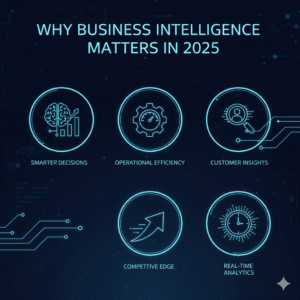The Big AI Learning Curve: How Business Owners Can Get Started
AI used to be something that people thought would happen in the future, but now it’s a must-have for businesses. But for a lot of business owners, the road to using AI seems impossible, like standing at the base of Mount Everest with nothing but willpower and the feeling that everyone else is already halfway up.
It takes a lot of work to learn AI in business, but it’s not impossible. A lot of executives don’t know where to start, even though 73% of them think AI will change their industry in the next three years. The many tools, complicated AI terms, and fear of making expensive mistakes all lead to analysis paralysis.
This complete guide will help you get started on your AI journey. You’ll learn how to spot chances, start small with pilot projects, pick the right tools, and create AI capabilities that last and make a difference in your business. Most importantly, you’ll learn that you don’t have to be a data scientist to use AI successfully in your business.
Getting to Know the Basics of AI
What AI Really Means for Your Company
Artificial Intelligence includes computer systems that can do things that normally require human intelligence. AI isn’t about taking over jobs from people for business owners; it’s about giving people more tools to work smarter, not harder.
Most AI applications for business are built on machine learning. You could say that it is software that gets better on its own as you use it. Over time, your email spam filter gets better at spotting unwanted messages thanks to machine learning.
Deep Learning is a more advanced type of machine learning that works like the human brain does when it processes information. This technology makes it possible for voice assistants, image recognition, and advanced predictions of how customers will act.
Natural Language Processing (NLP) lets computers understand and make human language. NLP is a big part of chatbots, sentiment analysis tools, and automated customer service responses.
Making AI Terms Clear
Confusing jargon often makes the AI learning curve steeper. What key terms really mean for your business:
- Algorithm: A set of rules that tells the computer how to fix a problem.
- Big Data: Lots of information that regular software has trouble processing
- Predictive analytics is the use of past data to guess what will happen in the future.
- Automation means using technology to do things without needing people to do them.
Knowing these basics will help you talk to AI vendors more clearly and make smart choices about how to use the technology.
Identifying AI Opportunities in Your Business
Finding out what your business needs
When you start with clear business problems instead of flashy technology, the AI learning curve becomes easier to handle. Look at your daily tasks to see if there are any that are repetitive, require a lot of data, or are prone to human error.
Ask yourself these questions to figure out what’s wrong:
- Which tasks take the most time but don’t help the strategy?
- Where do you have trouble recognizing patterns or analyzing data?
- What customer service problems could be solved by automating them around the clock?
- What processes would be better off with predictive insights?
AI in the Real World: Retail and E-Commerce
Retail and E-commerce
- Personalized product suggestions boost sales by 10% to 30%.
- Inventory optimization reduces waste and stockouts
- Dynamic pricing changes automatically based on market conditions.
Services for Professionals
- Document analysis and contract review save a lot of time doing things by hand.
- Automating client communication and setting up appointments
- Managing project timelines based on predictions
Making things
- Predictive maintenance stops expensive equipment from breaking down.
- Using computer vision systems for quality control
- Optimizing the supply chain by predicting demand
Health and Wellness
- Optimizing patient scheduling cuts down on wait times.
- Automated reminders for appointments cut down on no-shows.
- Analyzing health trends to plan for preventive care
Knowing how AI works in businesses like yours can help you think of ways to use it in your own company.
Starting Small: AI Test Projects
The Strength of Pilot Projects
According to the AI learning curve theory, starting small speeds up learning while lowering risk. Pilot projects serve as your training ground, allowing you to understand AI capabilities without massive upfront investments.
There are some things that all successful pilot projects have in common:
- Clear and measurable goals: “Cut customer response time by 30%” instead of “make customer service better”
- Limited scope: Start by focusing on one department or process
- Set evaluation periods of 3 to 6 months.
- Metrics for success: Establish baseline measurements for comparison
Picking Your First AI Project
Pick projects that are easy to see but not too hard to do. Customer service chatbots, automated email marketing, and basic data analysis tools are all examples of quick wins that help people trust the company.
This is an example of a learning curve: A restaurant in the area put in an AI-powered ordering system. They only took orders online at first, but after three months of talking to customers, they started taking phone orders as well. This step-by-step method gave staff time to get used to the changes while the system kept getting better.
Picking the Best AI Tools and Platforms
Looking at AI Solutions
When choosing an AI tool, the learning curve formula says to balance functionality, ease of use, and cost. Don’t let the most advanced features lure you in if they are more than you need or can handle right now.
Important things to think about when evaluating are:
- How hard is it for your team to use the user interface?
- Integration: Can it work with the software you already have?
- Can it grow with your business?
- Support and training: What kinds of help does the vendor offer?
- What information do you need to give for the data requirements?
Well-liked groups of AI tools
CRM, or Customer Relationship Management
AI-powered CRMs automatically rate leads, guess how customers will act, and suggest the best times to talk to them.
Platforms for Automating Marketing
These tools make email campaigns more personal, find the best times to post on social media, and look at customer journey data.
Tools for Business Intelligence
Use automated reporting and trend identification to turn raw data into useful information.
Platforms for Chatbots
Offer customer service around the clock while collecting useful data on interactions to make things better all the time.
Creating an AI team or working with experts
AI Expertise Inside vs. Outside
In business, the AI learning curve often needs help from outside sources, especially when it is first being put into place. You have three main ways to add AI features:
Bringing on AI experts
Best for big companies that have a lot of money to spend on AI and plans to use it for a long time. Needs competitive pay and investments in professional development that last.
Training Current Employees: This is great for businesses with employees who are good with technology and want to learn new skills. Courses, workshops, and certification programs that are available online can help people learn more about AI.
Working with AI consultants
Great for small to medium-sized businesses that need expert help but don’t want to hire someone full-time. Consultants help with implementation, training, and ongoing support.
Teaching your whole organization about AI
For AI to work well, everyone in the organization needs to understand it, not just the people who work with it. Employees are more likely to accept AI technologies if they get regular training, lunch-and-learn presentations, and hands-on demonstrations.
Start a “AI champion” program in which early adopters help train their coworkers and look for new ways to automate tasks.

Ethical Issues and Being Responsible AI Data Security and Privacy
Part of the AI learning curve is learning about rules and laws that must be followed. AI systems often require significant amounts of customer data, creating privacy and security responsibilities.
Important privacy practices are:
- Policies for collecting data that are clear
- Safe storage and sending of data
- Clear ways for people to give permission for data use
- Regular security audits and updates
Addressing AI Bias AI systems learn from past data, which could make existing biases worse. Regular audits of algorithms, a variety of training data, and ongoing monitoring all help make sure that AI systems are fair and just.
To be open and honest with customers and stakeholders, write down how you make decisions with AI.
How to Measure AI Success and ROI
Setting Goals for Success
The AI learning curve means more than just putting technology into use; it also means seeing a measurable effect on business. Before starting AI projects, you should set both quantitative and qualitative success metrics.
Some common ways to measure AI success are:
- Gains in efficiency: Less time spent on routine tasks
- Lowering costs: Less money spent on operations
- Improvements in revenue: More sales or more value for each customer over time
- Satisfaction of customers: Higher scores for service quality
- Satisfaction of employees: Less work that has to be done over and over again
How to figure out the AI return on investment
When figuring out the return on investment (ROI) for AI, you should think about both the direct costs (software, training, implementation) and the indirect benefits (better decision-making, competitive advantages).
Keep an eye on metrics over long periods of time because AI systems tend to get better at their jobs the more data they process and the more they learn from their interactions.
Learning and changing all the time
Keeping up with AI trends
The AI landscape changes quickly, so it’s important to keep learning in order to stay successful. The learning curve theory says that making small, regular investments in learning will get you better results than doing intensive training every now and then.
Suggested materials for learning:
- AI newsletters and publications for specific industries
- Courses and certifications for professional development
- AI conferences and events for networking
- Mastermind groups for business owners who are peers
- AI communities and forums on the web
Making an AI strategy that can change
To successfully implement AI, you need to be flexible and willing to change your plans based on results and the needs of the business as they change. Check on AI performance often, get feedback from users, and keep up with new technologies that could help your business.
Hold quarterly reviews of your AI strategy to see how far you’ve come, find new chances, and change the timelines for when things will be done.
Your Next Steps on the AI Path
Business owners can learn AI, but it’s not easy. With the right approach, though, they can do it. Pick one clear business problem that AI could help with. Then, look into the right tools and think about working with experts to help you get started.
Keep in mind that using AI is a long-term process, not a short-term one. Instead of using every technology right away, focus on building long-term skills that will help your business grow.
To be successful, you need to know what you need, start small, keep track of your results, and change your approach based on what happens in the real world.
Are you ready to use AI to change your business but need help getting over the learning curve? Work Kiwi helps business owners find AI opportunities, choose the right tools, and put in place solutions that show real results. Our knowledgeable team offers one-on-one consulting to make sure your AI journey gets off to a good start and grows in a way that fits with your business goals.






